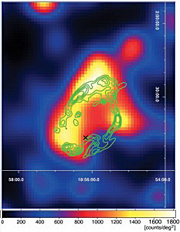- Number 304 |
- February 1, 2010
Fermi Telescope Closes in on Mystery of Cosmic Ray Acceleration

Supernova remnant W44 as
imaged by the Fermi telescope's
Large Area Telescope and
enhanced with a restoration
technique. The green contours
indicate the remnant seen with
infrared light. (Image courtesy
of NASA/DOE/LAT collaboration.)
Cosmic “rays”—which mostly consist of protons—are some of the most energetic particles in the universe. For nearly 100 years, they have also been some of the most enigmatic. Now, researchers from the Kavli Institute for Particle Astrophysics and Cosmology, jointly located at DOE's SLAC National Accelerator Laboratory and Stanford University, have announced a significant advance in the understanding of where cosmic rays come from. New data from the Fermi Gamma-ray Space Telescope’s Large Area Telescope collaboration offers insight into how, exactly, the universe accelerates these particles to such high energies.
“With Fermi, we finally have succeeded in getting information about spatial distribution from a supernova remnant in this energy band,” said LAT researcher Takaaki Tanaka. “This band is quite important for the study of particle acceleration in supernova remnants including determining the origin of cosmic rays.”
The high-energy cosmic rays appear to be coming from supernova remnants, the dying remains of exploded stars; the new result reveals the spatial distribution of this emission in one particular supernova remnant. This result is a significant step toward definitively determining how cosmic rays are accelerated in supernova remnants.
Full story: http://www.symmetrymagazine.org/breaking/2010/01/07/fermi-cosmic-rays/[Kelen Tuttle, 650.926.2585,
kelen.tuttle@slac.stanford.edu]
